» posted on Thursday, December 27th, 2012 by Linda Lou Burton
It’s Called Experience
Linda Burton posting from Pensacola, Florida traveling from Baton Rouge, Louisiana to Tallahassee, Florida – Country music stars travel a lot; so do politicians. Social media and viral videos may add another dimension as to how we share information, but nothing replaces face-to-face. It’s called experience. This year’s political campaign is a good example of the benefits of “up close and personal.” Candidates racked up the miles and people flocked to their rallies, each wanting the experience of the other. (I tried to get into a Denver rally, but tickets were long gone.) Those music stars don’t hide out in palatial music-star homes watching sales of their albums tote up. They tour. They know that people want the experience of them, and they in turn find out how people respond to what they do. And consider the million miles that Hillary Clinton has covered during her tenure as Secretary of State. She has met with world leaders on their turf, in their environment; such efforts not only allow the visitor a better understanding of why the other fellow looks, feels, and acts as they do, it shows the visitor’s respect for the places, and people, visited. And so it is with the Journey Across America, now 40% complete. Twenty capital cities lived in during the last 309 days; twenty capital cities experienced.
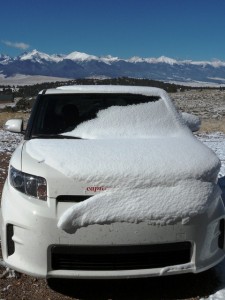 The Journey Across America now claims 18,989 miles traveled in the last 44 weeks. Not much compared to SOS Clinton perhaps; but a heck of a lot when you think about what it means. There are 5,792,029 people in those twenty capital cities that I understand much better now. With them, I have shared their adaptation to climate, weather, geology, the economy; all things that affect the basics – the layout of city streets, the food that people eat, the use of space, the everyday routine of life.
The Journey Across America now claims 18,989 miles traveled in the last 44 weeks. Not much compared to SOS Clinton perhaps; but a heck of a lot when you think about what it means. There are 5,792,029 people in those twenty capital cities that I understand much better now. With them, I have shared their adaptation to climate, weather, geology, the economy; all things that affect the basics – the layout of city streets, the food that people eat, the use of space, the everyday routine of life.
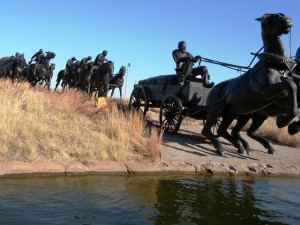 The last five capital cities – Santa Fe, Oklahoma City, Little Rock, Jackson, and Baton Rouge – have moved me from Rocky Mountain highs (Santa Fe is the highest capital city at 7,000 feet) across the plains to America’s Wetlands (Baton Rouge sits tucked behind levees with some neighborhoods below sea level). An amazing contrast, calling for amazing adaptations. Does a city invest in snow-plow equipment, or build dams to manage the water that surrounds?
The last five capital cities – Santa Fe, Oklahoma City, Little Rock, Jackson, and Baton Rouge – have moved me from Rocky Mountain highs (Santa Fe is the highest capital city at 7,000 feet) across the plains to America’s Wetlands (Baton Rouge sits tucked behind levees with some neighborhoods below sea level). An amazing contrast, calling for amazing adaptations. Does a city invest in snow-plow equipment, or build dams to manage the water that surrounds?
 History and settlement are major factors in the look and feel of today’s capital cities too; it’s the cultural heritage that makes each one unique. Does it have a Spanish feel? Or French, or British? What is the Native American story? The story of slavery, and human rights? Would the city have come to be without railroads? Did it begin as a trading post? How did people acquire their land? The architecture, the street names, the spirit that lingers to this day are revelations of a city’s past. Quite a lot to get a handle on; and I’m savoring every moment of the experience.
History and settlement are major factors in the look and feel of today’s capital cities too; it’s the cultural heritage that makes each one unique. Does it have a Spanish feel? Or French, or British? What is the Native American story? The story of slavery, and human rights? Would the city have come to be without railroads? Did it begin as a trading post? How did people acquire their land? The architecture, the street names, the spirit that lingers to this day are revelations of a city’s past. Quite a lot to get a handle on; and I’m savoring every moment of the experience.
What have I loved about these last five capital cities?
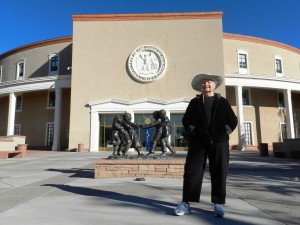 (Left) Santa Fe – I loved the fascination with architecture and art; the in-the-know nods on chiles, red and green; the layers of cultures and ancient roots; the magnetism it exudes for drawing people in; the refuge it provides behind its walls.
(Left) Santa Fe – I loved the fascination with architecture and art; the in-the-know nods on chiles, red and green; the layers of cultures and ancient roots; the magnetism it exudes for drawing people in; the refuge it provides behind its walls.
 (Right) Oklahoma City – I loved the wide open spaces, and the wind; the rush of a land-rush way of life; the mix of native tribes and cowboys and a highrise urban scene; the shading trees and winding canals added by planners, though nature didn’t think of it.
(Right) Oklahoma City – I loved the wide open spaces, and the wind; the rush of a land-rush way of life; the mix of native tribes and cowboys and a highrise urban scene; the shading trees and winding canals added by planners, though nature didn’t think of it.
 (Left) Little Rock – I loved the downtown playfulness; the humor and the history stretched along the river’s edge; the tree-lined city streets that witnessed crisis, and change; the acknowledgement of the past, and the moving on; the presidential pride.
(Left) Little Rock – I loved the downtown playfulness; the humor and the history stretched along the river’s edge; the tree-lined city streets that witnessed crisis, and change; the acknowledgement of the past, and the moving on; the presidential pride.
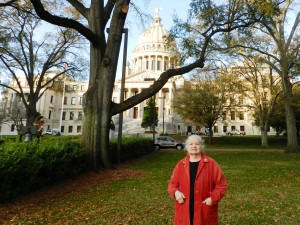 (Right) Jackson – I loved the old-time friendliness and charm, where a smile is really a hug and contentment ranks higher than cotton; the rocking chairs and easy pace; the music and the stories that so poignantly express the hurts and the joys of then, and now.
(Right) Jackson – I loved the old-time friendliness and charm, where a smile is really a hug and contentment ranks higher than cotton; the rocking chairs and easy pace; the music and the stories that so poignantly express the hurts and the joys of then, and now.
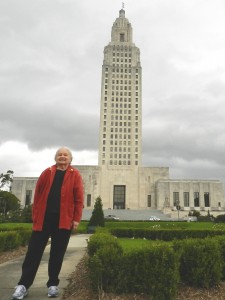 (Left) Baton Rouge – I loved the Cajun French of it, the joy of food and the good times roll; the dare to be what it wants to be; the audacity of the levees, standing up to the mighty Mississippi; the lazy bayous and moss-draped trees; plantation memories.
(Left) Baton Rouge – I loved the Cajun French of it, the joy of food and the good times roll; the dare to be what it wants to be; the audacity of the levees, standing up to the mighty Mississippi; the lazy bayous and moss-draped trees; plantation memories.
Since my last summary on October 13, I have layered up in sweaters against October mountain snows and sweated in 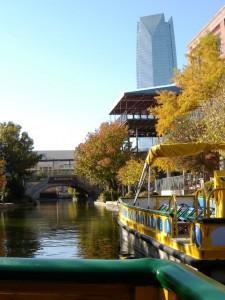 short-sleeved shirts on December’s southern streets. I have water taxied winding canals in a city with no natural lakes; wandered through trailing vines in a conservatory filled with tropical mist; walked through high desert sagebrush where the wind is crackling dry. I’ve seen houses made of clay and houses made of sod; houses with center
short-sleeved shirts on December’s southern streets. I have water taxied winding canals in a city with no natural lakes; wandered through trailing vines in a conservatory filled with tropical mist; walked through high desert sagebrush where the wind is crackling dry. I’ve seen houses made of clay and houses made of sod; houses with center 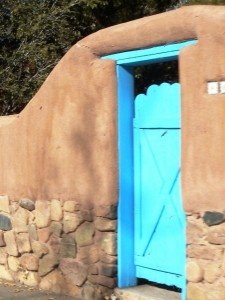 halls designed to bring the summer breezes in and houses with foot-thick walls designed to keep out heat, and cold, and enemies. I’ve seen oil rigs and cattle pens, wind farms and cotton farms; barges on
halls designed to bring the summer breezes in and houses with foot-thick walls designed to keep out heat, and cold, and enemies. I’ve seen oil rigs and cattle pens, wind farms and cotton farms; barges on 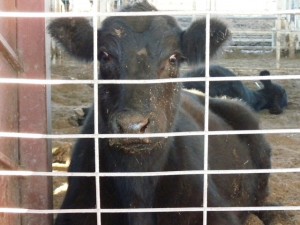 the riverways and tankers on the highways; the realities of commerce, in its many forms.
the riverways and tankers on the highways; the realities of commerce, in its many forms.
I’ve celebrated Christmas trees and fireworks, bonfires and school choirs; deer grazing by my window while I eat. I’ve been hugged by Santa Claus, welcomed by cousin Jayne just discovered in Oklahoma, visited by brother Craig, who drove to meet me Christmas day in New Orleans. I’ve dined on Spanish  omelets smothered in green chile sauce, Creole omelets stuffed with shrimp fresh from the Gulf, prime-cut cattlemen’s steak aged to perfection, catfish in a basket, peanut butter crackers in the car.
omelets smothered in green chile sauce, Creole omelets stuffed with shrimp fresh from the Gulf, prime-cut cattlemen’s steak aged to perfection, catfish in a basket, peanut butter crackers in the car.
I’ve visited memorials to the dead and sites of violence and tragedy. I’ve stood where writers were inspired to write; seen what musicians and artists and planners and builders were inspired to create. But most of all, I’ve listened, for people love nothing better than the chance to talk about home; I’ve watched their eyes light up with pride of place. Campaign maps may paint us red, or blue, but that gets nowhere near the heart of things. We are more than that.
I’m learning a lot on this Journey Across America. It’s called experience, and I highly recommend it.

